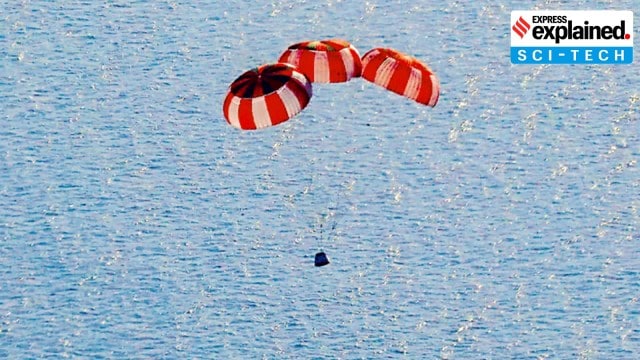The Indian Space Research Organisation (ISRO) successfully carried out its first Integrated Air Drop Test (IADT-1) on Sunday to evaluate the parachute-based deceleration system for the upcoming Gaganyaan mission. The system is critical for ensuring safe recovery of the crew module — the capsule in which astronauts sit during a human flight — during re-entry and landing.
The first crewed mission under the Gaganyaan programme is scheduled for 2027, and the first uncrewed mission is likely toward the end of this year.

What is an Integrated Air Drop Test?
An air drop test recreates the final leg of a spacecraft’s journey back to Earth. An aircraft or helicopter drops the spacecraft from a height to test various systems under different circumstances. These include the deployment of the parachute system if the mission is aborted mid-flight, system performance when one parachute fails to open, and the spacecraft’s orientation and safety during splashdown.
The test, however, cannot simulate actual re-entry scenarios as helicopters cannot carry spacecraft high enough. To create re-entry scenarios, sub-orbital or orbital flights carry the spacecraft outside Earth’s atmosphere.
In October 2023, ISRO carried out the Test Vehicle Abort Mission (TV-D1), which launched a single-stage test vehicle for sub-orbital flight with the crew module to demonstrate the performance of the crew escape system.
How was the air drop test carried out?
The test simulated a scenario in which the mission is aborted at the launch pad and the crew is ejected from the capsule. To execute this, a 4.8-tonne dummy crew module was dropped from a height of 3 kilometres by a Chinook helicopter.
Upon release, the onboard avionics system autonomously commanded vehicle deceleration, which triggered the deployment of the parachute system, comprising 10 parachutes. The parachutes successfully decelerated the capsule to a safe splashdown speed.
Story continues below this ad
In a statement, ISRO said, “Main parachutes reduced the terminal velocity of the simulated crew module to about 8 m/s.” Typically, for spacecraft re-entering Earth’s atmosphere, parachutes are deployed at velocities around 150 m/s.
The test also verified the crew module’s orientation during splashdown and its subsequent recovery.
How did the parachute system work?
The crew module was equipped with four different types of parachutes. The deceleration began with the deployment of two 2.5-metre Apex Cover Separation Parachutes, which remove the apex cover from the descending vehicle. The apex cover protects the parachute compartment from re-entry heat.
Then, two 5.8-metre drogue parachutes were deployed to stabilise the crew module and reduce its velocity significantly.
Story continues below this ad
Once the drogue parachutes completed the first deceleration stage, they were separated to deploy three 3.4-metre pilot parachutes, which independently deployed the three 25-metre main parachutes. These parachutes reduced the capsule’s velocity to a safe splashdown speed. They were released before the recovery team retrieved the crew module.
Where is the current status of the Gaganyaan mission?
The objective of the Gaganyaan mission is to send Indian astronauts to low-earth orbit by 2027. Before this happens, ISRO needs to carry out a series of tests to check the performance of safety systems.
After the success of TV-D1, ISRO is currently preparing to conduct a second test vehicle mission in the third quarter of 2025. The TV-D2 mission is being designed to simulate an abort scenario and demonstrate the Gaganyaan crew escape system at a more complex level than TV-D1.
The first uncrewed mission, Gaganyaan-1 (G-1), which is scheduled for the fourth quarter of 2025, will demonstrate technology preparedness before the manned mission. The unmanned mission will carry an unpressurised crew module to space and back. The G-1 mission’s crew module will not have the Environment Control and Life Support System, which ensures an Earth-like environment inside the module.
Story continues below this ad
The crew module and service module structures, along with some motors, have already been manufactured. Propulsion systems for the crew module, service module, and crew escape system have also been tested. The LVM3 vehicle, ISRO’s largest rocket, has been fully human-rated, meaning redundancies have been introduced to ensure flight safety for humans. The Life Support System model has been manufactured.
The Orbital Module Preparation Facility (which houses the crew module and service module), Gaganyaan Control Centre, Gaganyaan Control facility, crew training facility, and second launch pad modifications have been completed. A plan for crew module recovery after splashdown has been developed.
ISRO is also preparing to launch a second and a third uncrewed mission — G-2 and G-3 — next year.








































